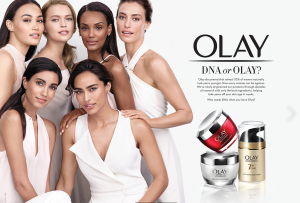For Best Results, Be 20

Deconstruction
Companies that market anti-aging products have been criticized and boycotted by many who object to the message that aging is not okay. In order to keep profiting from their anti-aging products, companies like Olay have had to become very strategic in their marketing and advertising campaigns. They have had to develop increasingly subtle ways to make women insecure about aging without offending them. This ad for various anti-aging creams by Olay is a perfect example of how companies subtly intimate that age is ugly, compelling women to consume cosmetic products which promise to delay or even stop the inevitable process of aging.
In promoting anti-aging products, this ad features young women who show no visible signs of aging. These women are, arguably, young. Their presence in the ad suggests that young is actually old and that by age 25-30 (which most people would consider young) there is a need to begin using anti-aging products. The ad also implies that these are average women who appear “ageless” because of Olay products and therefore, “every woman can be ageless” too, if they use Olay. This is certainly untrue. Not only are these women young to begin with, they surely do not represent the average woman. They are professional models and their faces and bodies have most likely been smoothed, de-wrinkled and otherwise perfected through the use of photo editing softwares. By using theses youthful, beautiful models in their ads, Olay effectively expands their target consumer base to include women 30 and under while holding older women to an unattainable “ageless” ideal.
According to the ad, 10% of women supposedly possess some special DNA which causes them to appear younger than they are. Ironically, DNA is the reason we age. Aging can be attributed to the gradual impairment of DNA repair processes (Scientist Magazine). Aging occurs at the cellular level so an anti-aging topical cream is not likely to change our DNA nor reverse the deterioration of our cells.
This sort of false advertising imposes unreasonable, unrealizable beauty standards on women, making them feel ashamed of their aging bodies. In subverting this ad, I expose Olay’s real message to women: if you are old, you are ugly.

Jamming Philosophy
Firstly, my jammed or altered ad makes explicit Olay’s real message to women: once you are “old”, you are ugly. I changed the original phrase “DNA or Olay?” to read “Do Not Age okay?”, using DNA as an acronym. What Olay is really telling women in their advertisement campaigns is buy Olay anti-aging products so you do not age.
Next, I re-wrote the blurb which, on the original ad, began with “Olay discovered that almost 10% of women naturally look years younger.” In my edit, I first comment on the absurd use of young models for an anti-aging campaign (“No one wants to look 30”). I then allude to the ineffectiveness of anti-aging creams and their inability to yield any significant, lasting results (“…look up to one day younger!”). To emphasize this ineffectiveness, I suggest that anti-aging cream may only be considered “effective” if the user if already young (“For best results, be 20”).
Finally, I changed the phrase “Who needs DNA when you have Olay” to “Who needs confidence when you have Olay?”. This is meant to communicate the real and only effect of anti-aging advertisement and products: damage to women’s confidence. It is also meant to comment on the dangerous tendency of women to rely on their appearance for their self-esteem and confidence. Finally, I imply that if women are truly confident, they have no need for anti-aging creams and other cosmetic products and so, are not susceptible to these sorts of injurious ads. Confident women thwart companies like Olay’s efforts to target and exploit women’s insecurities for profit.
Olay ad retrieved from: http://thewallgroup.com/artist.php?artist_id=161
Works Cited
The Scientist Staff. “How We Age.” The Scientist. N.p., 1 Mar. 2015. Web. 28 June 2017.